Analysis of AASB 6 and AASB Framework in Advance Financial Accounting
VerifiedAdded on 2022/12/20
|6
|1184
|91
Report
AI Summary
This report provides an in-depth analysis of the differences and similarities between the Australian Accounting Standards Board (AASB) 6 and the AASB Framework. The report begins with an introduction to both standards, explaining their purpose and scope within the Australian accounting system. The core of the report focuses on contrasting AASB 6, which pertains to the evaluation of mineral resources, with the broader AASB Framework, which sets the standards for financial statement preparation and presentation. Key differences highlighted include the specific application dates and the objectives of each standard. Furthermore, the report identifies the commonalities between the two standards, such as their applicability to companies operating in Australia and their shared goal of safeguarding stakeholders. The report also provides a conclusion summarizing the key findings, emphasizing the role of both standards in ensuring accurate and uniform financial reporting, which facilitates stakeholder understanding and comparison of financial performance. The report includes references to support the analysis.
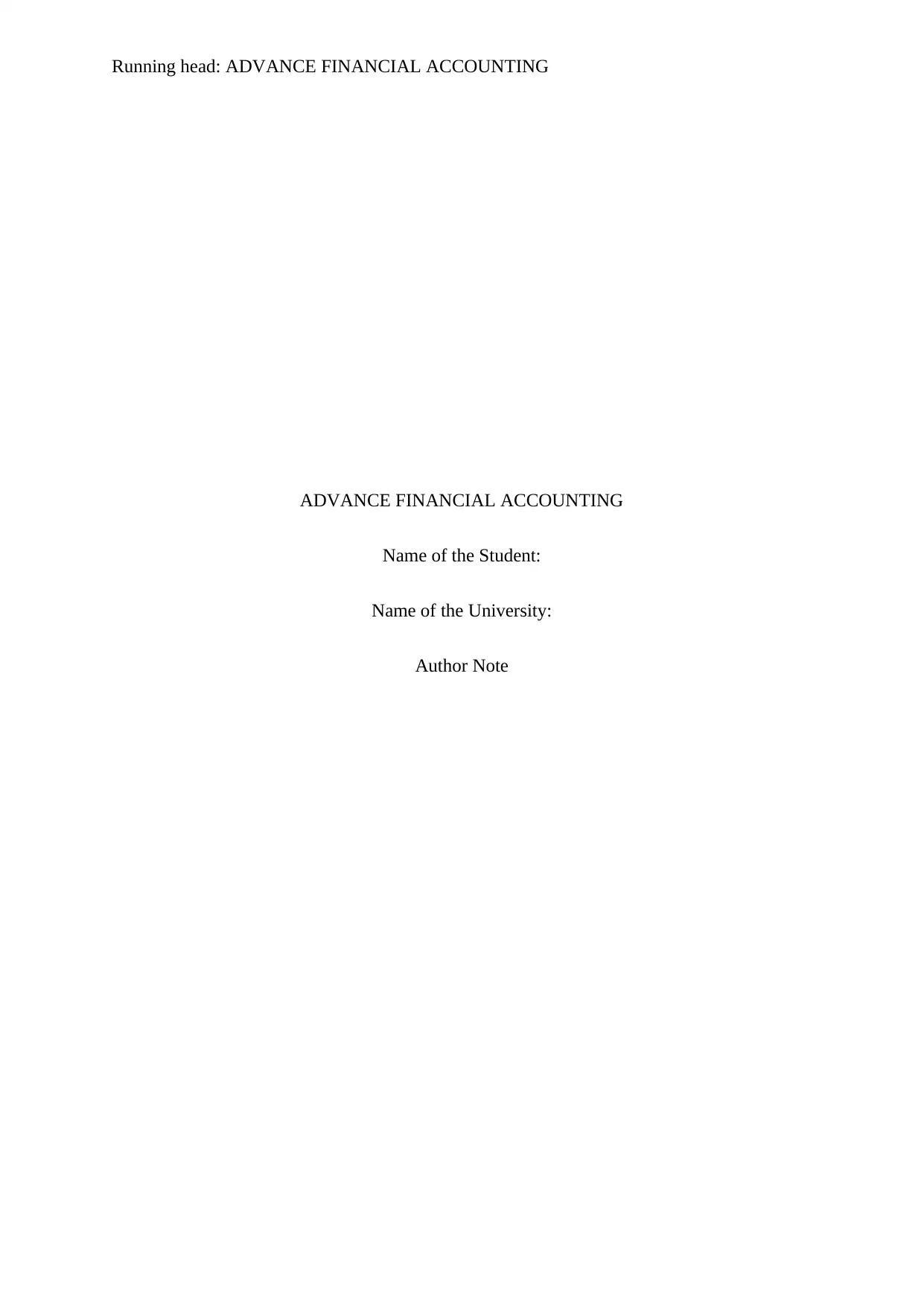
Running head: ADVANCE FINANCIAL ACCOUNTING
ADVANCE FINANCIAL ACCOUNTING
Name of the Student:
Name of the University:
Author Note
ADVANCE FINANCIAL ACCOUNTING
Name of the Student:
Name of the University:
Author Note
Paraphrase This Document
Need a fresh take? Get an instant paraphrase of this document with our AI Paraphraser
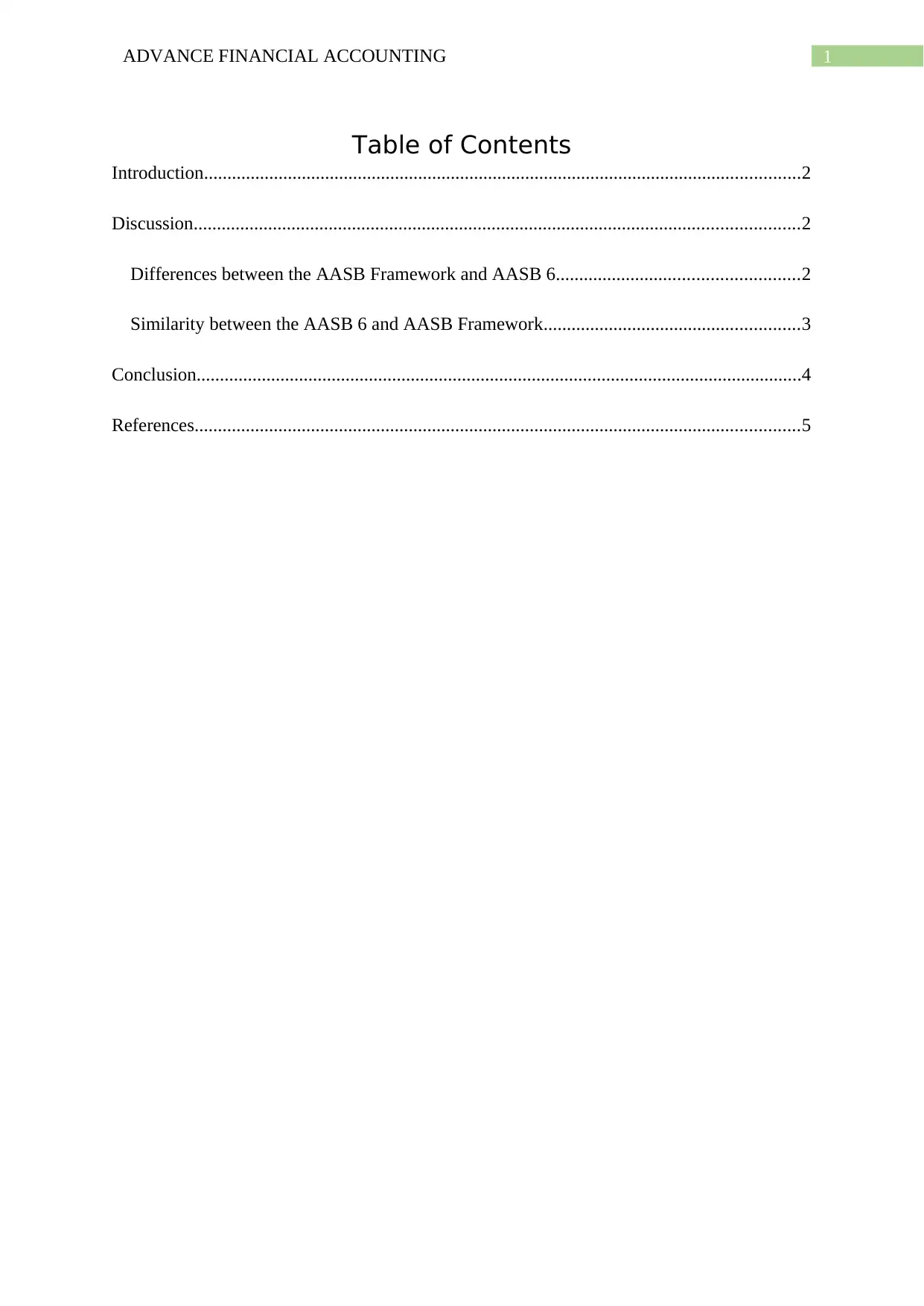
1ADVANCE FINANCIAL ACCOUNTING
Table of Contents
Introduction................................................................................................................................2
Discussion..................................................................................................................................2
Differences between the AASB Framework and AASB 6....................................................2
Similarity between the AASB 6 and AASB Framework.......................................................3
Conclusion..................................................................................................................................4
References..................................................................................................................................5
Table of Contents
Introduction................................................................................................................................2
Discussion..................................................................................................................................2
Differences between the AASB Framework and AASB 6....................................................2
Similarity between the AASB 6 and AASB Framework.......................................................3
Conclusion..................................................................................................................................4
References..................................................................................................................................5
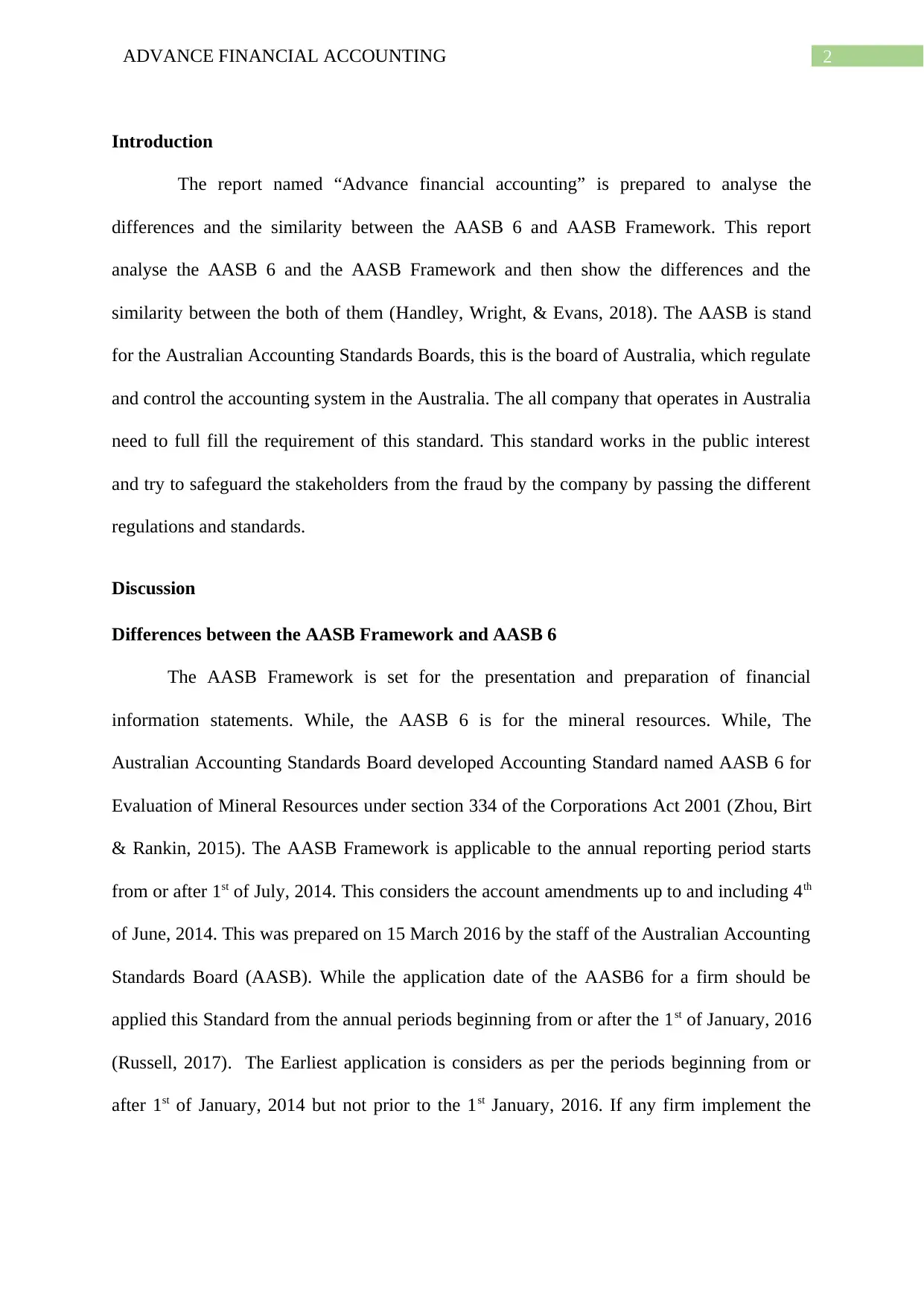
2ADVANCE FINANCIAL ACCOUNTING
Introduction
The report named “Advance financial accounting” is prepared to analyse the
differences and the similarity between the AASB 6 and AASB Framework. This report
analyse the AASB 6 and the AASB Framework and then show the differences and the
similarity between the both of them (Handley, Wright, & Evans, 2018). The AASB is stand
for the Australian Accounting Standards Boards, this is the board of Australia, which regulate
and control the accounting system in the Australia. The all company that operates in Australia
need to full fill the requirement of this standard. This standard works in the public interest
and try to safeguard the stakeholders from the fraud by the company by passing the different
regulations and standards.
Discussion
Differences between the AASB Framework and AASB 6
The AASB Framework is set for the presentation and preparation of financial
information statements. While, the AASB 6 is for the mineral resources. While, The
Australian Accounting Standards Board developed Accounting Standard named AASB 6 for
Evaluation of Mineral Resources under section 334 of the Corporations Act 2001 (Zhou, Birt
& Rankin, 2015). The AASB Framework is applicable to the annual reporting period starts
from or after 1st of July, 2014. This considers the account amendments up to and including 4th
of June, 2014. This was prepared on 15 March 2016 by the staff of the Australian Accounting
Standards Board (AASB). While the application date of the AASB6 for a firm should be
applied this Standard from the annual periods beginning from or after the 1st of January, 2016
(Russell, 2017). The Earliest application is considers as per the periods beginning from or
after 1st of January, 2014 but not prior to the 1st January, 2016. If any firm implement the
Introduction
The report named “Advance financial accounting” is prepared to analyse the
differences and the similarity between the AASB 6 and AASB Framework. This report
analyse the AASB 6 and the AASB Framework and then show the differences and the
similarity between the both of them (Handley, Wright, & Evans, 2018). The AASB is stand
for the Australian Accounting Standards Boards, this is the board of Australia, which regulate
and control the accounting system in the Australia. The all company that operates in Australia
need to full fill the requirement of this standard. This standard works in the public interest
and try to safeguard the stakeholders from the fraud by the company by passing the different
regulations and standards.
Discussion
Differences between the AASB Framework and AASB 6
The AASB Framework is set for the presentation and preparation of financial
information statements. While, the AASB 6 is for the mineral resources. While, The
Australian Accounting Standards Board developed Accounting Standard named AASB 6 for
Evaluation of Mineral Resources under section 334 of the Corporations Act 2001 (Zhou, Birt
& Rankin, 2015). The AASB Framework is applicable to the annual reporting period starts
from or after 1st of July, 2014. This considers the account amendments up to and including 4th
of June, 2014. This was prepared on 15 March 2016 by the staff of the Australian Accounting
Standards Board (AASB). While the application date of the AASB6 for a firm should be
applied this Standard from the annual periods beginning from or after the 1st of January, 2016
(Russell, 2017). The Earliest application is considers as per the periods beginning from or
after 1st of January, 2014 but not prior to the 1st January, 2016. If any firm implement the
⊘ This is a preview!⊘
Do you want full access?
Subscribe today to unlock all pages.

Trusted by 1+ million students worldwide
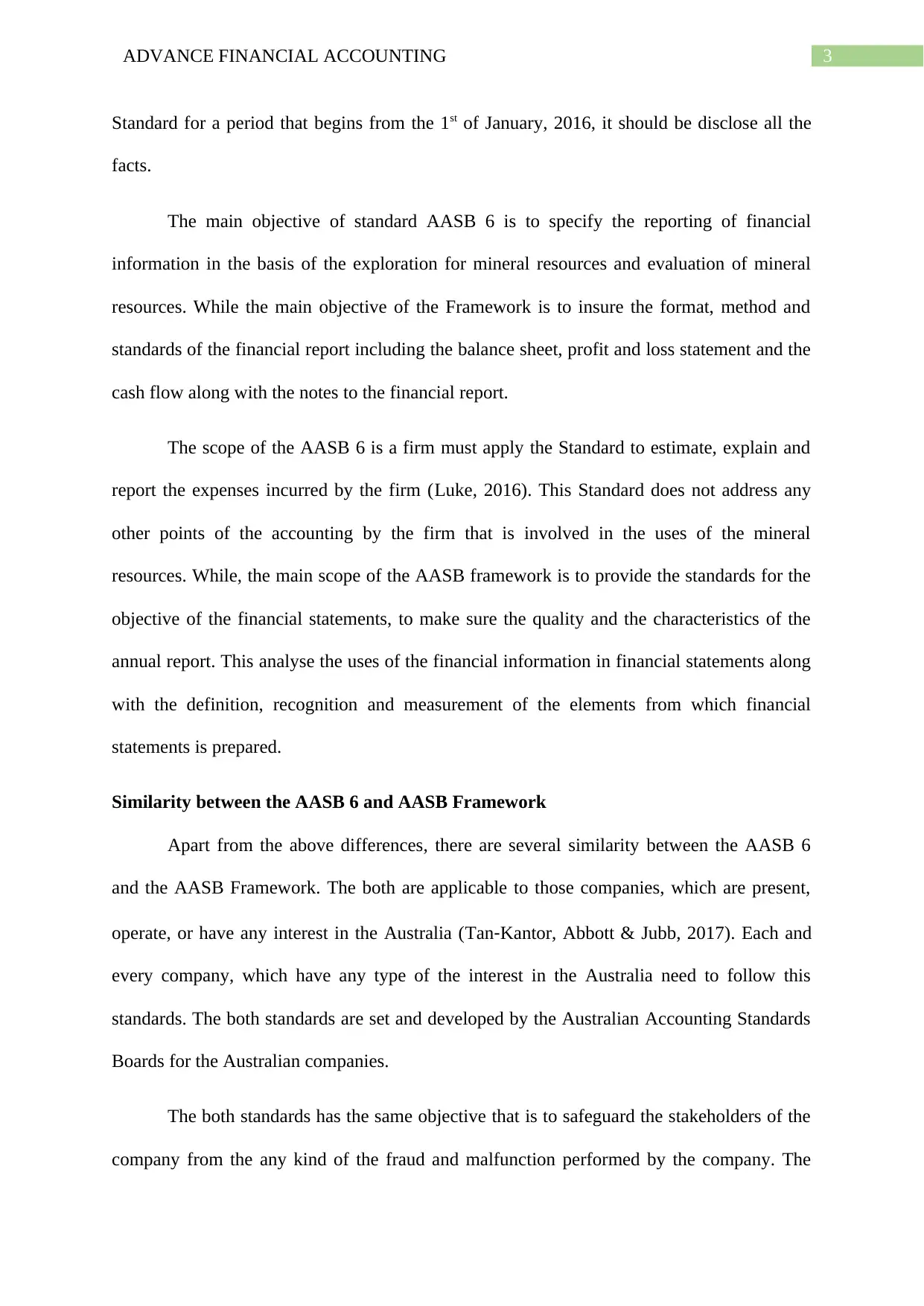
3ADVANCE FINANCIAL ACCOUNTING
Standard for a period that begins from the 1st of January, 2016, it should be disclose all the
facts.
The main objective of standard AASB 6 is to specify the reporting of financial
information in the basis of the exploration for mineral resources and evaluation of mineral
resources. While the main objective of the Framework is to insure the format, method and
standards of the financial report including the balance sheet, profit and loss statement and the
cash flow along with the notes to the financial report.
The scope of the AASB 6 is a firm must apply the Standard to estimate, explain and
report the expenses incurred by the firm (Luke, 2016). This Standard does not address any
other points of the accounting by the firm that is involved in the uses of the mineral
resources. While, the main scope of the AASB framework is to provide the standards for the
objective of the financial statements, to make sure the quality and the characteristics of the
annual report. This analyse the uses of the financial information in financial statements along
with the definition, recognition and measurement of the elements from which financial
statements is prepared.
Similarity between the AASB 6 and AASB Framework
Apart from the above differences, there are several similarity between the AASB 6
and the AASB Framework. The both are applicable to those companies, which are present,
operate, or have any interest in the Australia (Tan‐Kantor, Abbott & Jubb, 2017). Each and
every company, which have any type of the interest in the Australia need to follow this
standards. The both standards are set and developed by the Australian Accounting Standards
Boards for the Australian companies.
The both standards has the same objective that is to safeguard the stakeholders of the
company from the any kind of the fraud and malfunction performed by the company. The
Standard for a period that begins from the 1st of January, 2016, it should be disclose all the
facts.
The main objective of standard AASB 6 is to specify the reporting of financial
information in the basis of the exploration for mineral resources and evaluation of mineral
resources. While the main objective of the Framework is to insure the format, method and
standards of the financial report including the balance sheet, profit and loss statement and the
cash flow along with the notes to the financial report.
The scope of the AASB 6 is a firm must apply the Standard to estimate, explain and
report the expenses incurred by the firm (Luke, 2016). This Standard does not address any
other points of the accounting by the firm that is involved in the uses of the mineral
resources. While, the main scope of the AASB framework is to provide the standards for the
objective of the financial statements, to make sure the quality and the characteristics of the
annual report. This analyse the uses of the financial information in financial statements along
with the definition, recognition and measurement of the elements from which financial
statements is prepared.
Similarity between the AASB 6 and AASB Framework
Apart from the above differences, there are several similarity between the AASB 6
and the AASB Framework. The both are applicable to those companies, which are present,
operate, or have any interest in the Australia (Tan‐Kantor, Abbott & Jubb, 2017). Each and
every company, which have any type of the interest in the Australia need to follow this
standards. The both standards are set and developed by the Australian Accounting Standards
Boards for the Australian companies.
The both standards has the same objective that is to safeguard the stakeholders of the
company from the any kind of the fraud and malfunction performed by the company. The
Paraphrase This Document
Need a fresh take? Get an instant paraphrase of this document with our AI Paraphraser
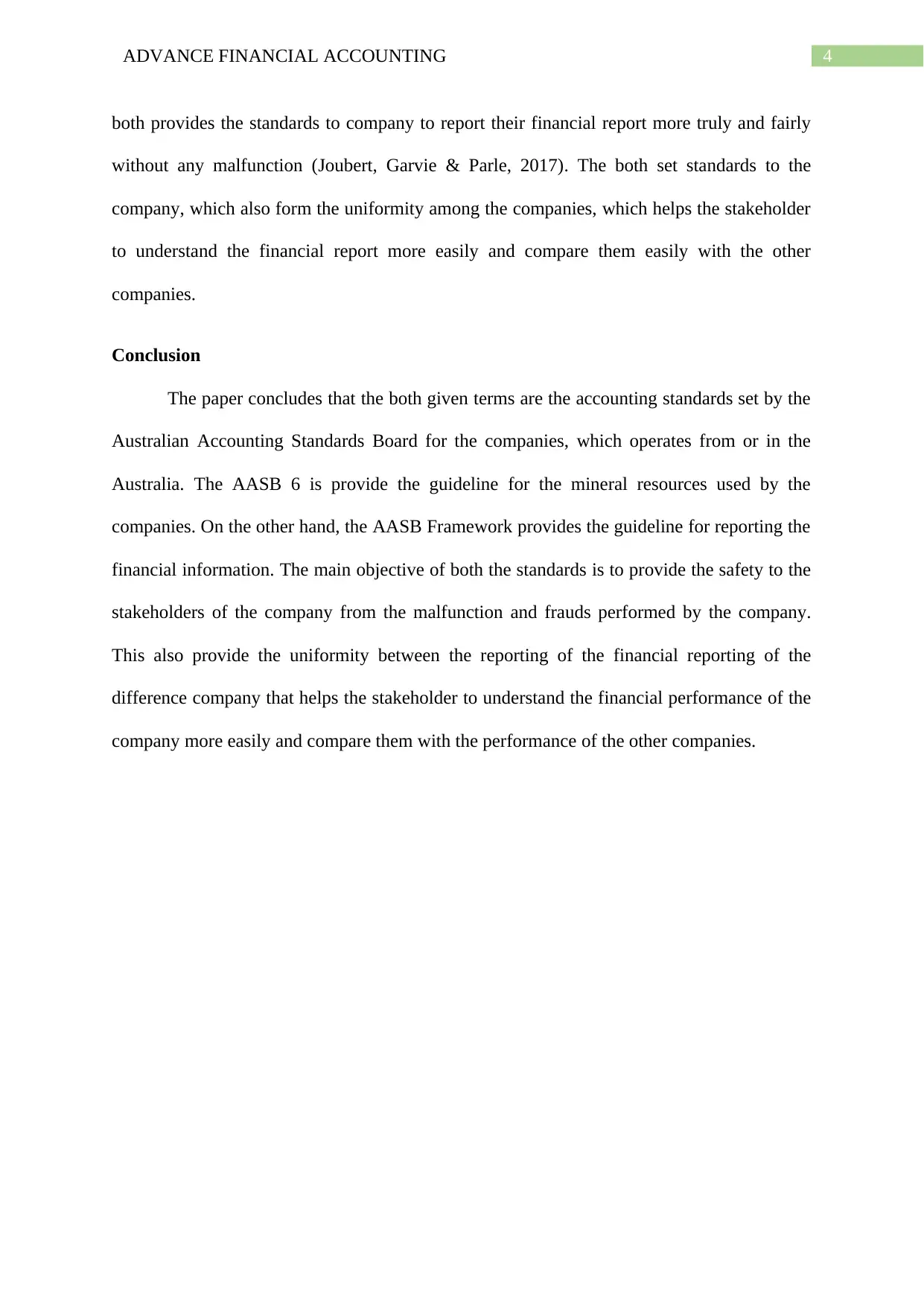
4ADVANCE FINANCIAL ACCOUNTING
both provides the standards to company to report their financial report more truly and fairly
without any malfunction (Joubert, Garvie & Parle, 2017). The both set standards to the
company, which also form the uniformity among the companies, which helps the stakeholder
to understand the financial report more easily and compare them easily with the other
companies.
Conclusion
The paper concludes that the both given terms are the accounting standards set by the
Australian Accounting Standards Board for the companies, which operates from or in the
Australia. The AASB 6 is provide the guideline for the mineral resources used by the
companies. On the other hand, the AASB Framework provides the guideline for reporting the
financial information. The main objective of both the standards is to provide the safety to the
stakeholders of the company from the malfunction and frauds performed by the company.
This also provide the uniformity between the reporting of the financial reporting of the
difference company that helps the stakeholder to understand the financial performance of the
company more easily and compare them with the performance of the other companies.
both provides the standards to company to report their financial report more truly and fairly
without any malfunction (Joubert, Garvie & Parle, 2017). The both set standards to the
company, which also form the uniformity among the companies, which helps the stakeholder
to understand the financial report more easily and compare them easily with the other
companies.
Conclusion
The paper concludes that the both given terms are the accounting standards set by the
Australian Accounting Standards Board for the companies, which operates from or in the
Australia. The AASB 6 is provide the guideline for the mineral resources used by the
companies. On the other hand, the AASB Framework provides the guideline for reporting the
financial information. The main objective of both the standards is to provide the safety to the
stakeholders of the company from the malfunction and frauds performed by the company.
This also provide the uniformity between the reporting of the financial reporting of the
difference company that helps the stakeholder to understand the financial performance of the
company more easily and compare them with the performance of the other companies.
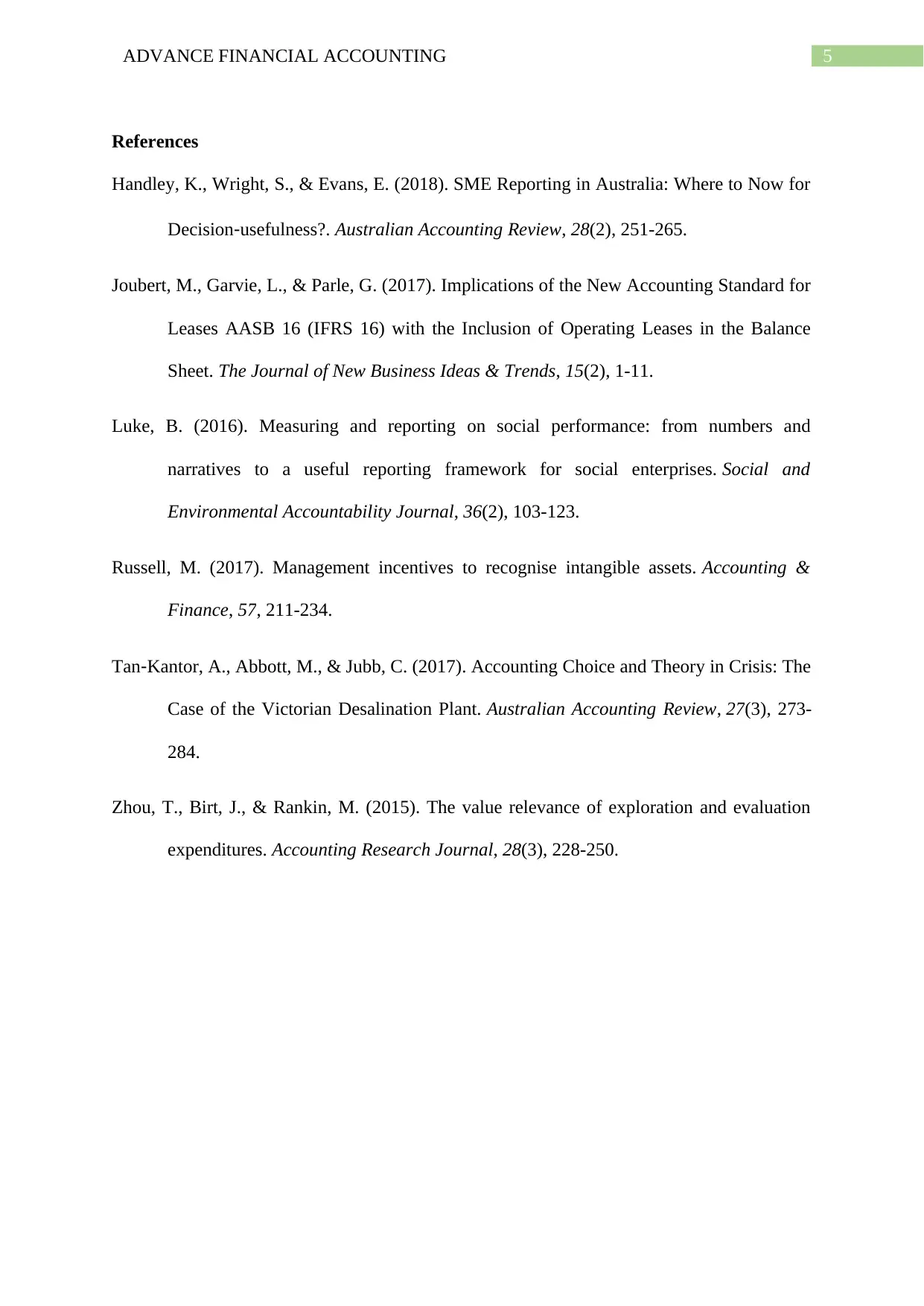
5ADVANCE FINANCIAL ACCOUNTING
References
Handley, K., Wright, S., & Evans, E. (2018). SME Reporting in Australia: Where to Now for
Decision‐usefulness?. Australian Accounting Review, 28(2), 251-265.
Joubert, M., Garvie, L., & Parle, G. (2017). Implications of the New Accounting Standard for
Leases AASB 16 (IFRS 16) with the Inclusion of Operating Leases in the Balance
Sheet. The Journal of New Business Ideas & Trends, 15(2), 1-11.
Luke, B. (2016). Measuring and reporting on social performance: from numbers and
narratives to a useful reporting framework for social enterprises. Social and
Environmental Accountability Journal, 36(2), 103-123.
Russell, M. (2017). Management incentives to recognise intangible assets. Accounting &
Finance, 57, 211-234.
Tan‐Kantor, A., Abbott, M., & Jubb, C. (2017). Accounting Choice and Theory in Crisis: The
Case of the Victorian Desalination Plant. Australian Accounting Review, 27(3), 273-
284.
Zhou, T., Birt, J., & Rankin, M. (2015). The value relevance of exploration and evaluation
expenditures. Accounting Research Journal, 28(3), 228-250.
References
Handley, K., Wright, S., & Evans, E. (2018). SME Reporting in Australia: Where to Now for
Decision‐usefulness?. Australian Accounting Review, 28(2), 251-265.
Joubert, M., Garvie, L., & Parle, G. (2017). Implications of the New Accounting Standard for
Leases AASB 16 (IFRS 16) with the Inclusion of Operating Leases in the Balance
Sheet. The Journal of New Business Ideas & Trends, 15(2), 1-11.
Luke, B. (2016). Measuring and reporting on social performance: from numbers and
narratives to a useful reporting framework for social enterprises. Social and
Environmental Accountability Journal, 36(2), 103-123.
Russell, M. (2017). Management incentives to recognise intangible assets. Accounting &
Finance, 57, 211-234.
Tan‐Kantor, A., Abbott, M., & Jubb, C. (2017). Accounting Choice and Theory in Crisis: The
Case of the Victorian Desalination Plant. Australian Accounting Review, 27(3), 273-
284.
Zhou, T., Birt, J., & Rankin, M. (2015). The value relevance of exploration and evaluation
expenditures. Accounting Research Journal, 28(3), 228-250.
⊘ This is a preview!⊘
Do you want full access?
Subscribe today to unlock all pages.

Trusted by 1+ million students worldwide
1 out of 6
Related Documents
Your All-in-One AI-Powered Toolkit for Academic Success.
+13062052269
info@desklib.com
Available 24*7 on WhatsApp / Email
![[object Object]](/_next/static/media/star-bottom.7253800d.svg)
Unlock your academic potential
Copyright © 2020–2025 A2Z Services. All Rights Reserved. Developed and managed by ZUCOL.




